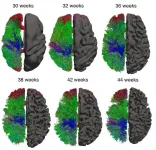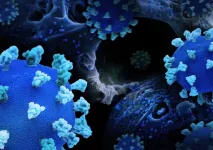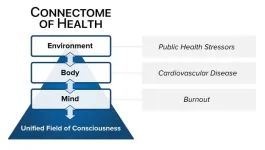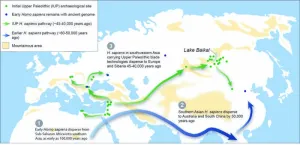(Press-News.org) A single brain is unfathomably complex. So brain researchers, whether they’re looking at datasets built from 300,000 neurons in 81 mice or from MRIs of 1,200 young adults, are now dealing with so much information that they must also come up with new methods to comprehend it. Developing new analysis tools has become as important as using them to understand brain health and development.
A team including researchers at the University of Washington recently used new software to compare MRIs from 300 babies and discovered that myelin, a part of the brain’s so-called white matter, develops much slower after birth. The researchers published their findings Aug. 7 in the Proceedings of the National Academy of Sciences.
UW News spoke with senior author Ariel Rokem, a UW research associate professor in the psychology department and a data science fellow in the eScience Institute, about the paper and his research approach.
What topics do you research and how?
Ariel Rokem: My group works in neuroinformatics, which focuses on building methods and software for analyzing neuroscience data. We focus specifically on MRI measurements in human brains. A brain is made out of a big network of connections between different areas. Within our brains, we have these big bundles of connections called white matter that contain lots of axons, which are the long, branching parts of neurons that let them talk to each other across pretty large distances. So we use MRI to find these bundles in every person in a study and then make sense of the tissue within these bundles. From that, we can find differences between people who have certain diseases and those who don’t, or differences in development or cognitive abilities.
How does this approach differ from how brain research was practiced historically?
AR: For many years, researchers would take test subjects over to their local hospital or MRI center and collect some data. And people still do this. In fact, we have one of these scanners at the new UW Center for Human Neuroscience, which I am part of. But more recent approaches involve collecting much larger amounts of data. For example, it would be hard for anyone here in the department at the UW to collect data from more than 1,000 individuals. But a few years ago, the National Institutes of Health funded what’s called the Human Connectome Project to do exactly that — get a sample of 1,200 healthy, grown-up people, and collect pretty large amounts of data on each of them. In neuroinformatics we take those kinds of datasets and develop the tools to study them.
What discoveries have these methods led to within brain science?
AR: Our recent paper is a good example. Our team used a large, openly available dataset from the Developing Human Connectome Project, which collects data from newborn infants in the first few days of life. We were looking at how white matter develops in these scans of more than 300 babies. My collaborator and lead author Mareike Grotheer, at the Philipps University of Marburg, had previously taken software for finding white matter bundles in adults and adapted it to work on babies’ brains. In this study, we scaled her approach up using cloud computing. We were looking at how myelin, a fatty sheath that insulates axons, grows in white matter.
We know from other studies that abnormal myelin development is associated with many developmental and mental health disorders, from chronic depression to schizophrenia. But before this study we still didn’t know how birth changes the course of myelin development.
We had several hypotheses that we wanted to test. One is, well, that it doesn’t matter when exactly you were born; it just matters how much time passed from conception to when you’re scanned. Another was that it matters only how long after conception you were born, and it didn’t matter how long after birth you were scanned. And we had a third hypothesis that says both of these things matter: how long the baby spent gestating in the mother’s womb, and how much time passed from birth until the time of the scan. So we were comparing scans from babies who were born at different gestational ages, ranging from very early premature birth, up to babies who were born a couple of weeks after the full term of 40 weeks. Because we had this large dataset to work with, we could really chart how babies’ brains change in the first few days and weeks of life.
We found that the data supports that both the gestational age at birth and the gestational age at time of scan mattered, but there’s an inflection point right at birth. Right then, development of these bundles that we were looking at slows down dramatically. It’s a basic fact, but we didn’t know this until now, and we found it by examining publicly available data. This has implications for our basic understanding of early-life brain development, and implications for the ways that we might mitigate the adverse effects of premature birth. Perhaps, for instance, creating a “womb-like” environment after birth could offset this slowed development and give the brains of premature babies more time to develop.
What are you looking to investigate with these methods moving forward?
AR: We’re starting to ask questions about brain connections related to autism spectrum disorder and to schizophrenia. We’re also now part of the UW’s ACT Study, or the Adult Changes in Thought Study. It’s been around for almost 30 years, following a large cohort of people in the Seattle area as they are aging. In the recent round of that study, we’ve added MRI measurements. We’re developing methods to make inferences about white matter bundles in people who are aging.
Additional co-authors on this paper are David Bloom, a former UW post-baccalaureate student in the psychology department; John Kruper, a UW doctoral student in the psychology department; Adam Richie-Halford, a former UW postdoctoral researcher in the psychology department; Stephanie Zika and Vicente A. Aguilera González at Philipps University of Marburg; and Jason D. Yeatman and Kalanit Grill-Spector at Stanford University. This research was funded by the National Institute of Mental Health and the National Eye Institute.
For more information, contact Rokem at arokem@uw.edu.
END
Q&A: How new software is changing our understanding of human brain development
2023-09-22
ELSE PRESS RELEASES FROM THIS DATE:
Clinical trial to test immune modulation strategy for hospitalized COVID-19 patients begins
2023-09-22
A clinical trial has launched to test whether early intensive immune modulation for hospitalized COVID-19 patients with relatively mild illness is beneficial. The placebo-controlled study, part of the global clinical trials consortium known as Strategies and Treatments for Respiratory Infections and Viral Emergencies (STRIVE), will enroll approximately 1,500 people at research sites around the world. It is supported by the National Institutes of Health’s National Institute of Allergy and Infectious Diseases (NIAID) in partnership with NIH’s National Center for Advancing Translational Sciences (NCATS).
Immune ...
Five factors that assess well-being of science predict support for increasing US science funding
2023-09-22
PHILADELPHIA – A study in the Proceedings of the National Academy of Sciences (PNAS) identifies five factors that Annenberg Public Policy Center (APPC) researchers say reflect public assessments of science and are associated with public support for increasing funding of science and support for federal funding of basic research. These factors are whether science and scientists are perceived to be credible and prudent, and whether their work is perceived to be untainted by bias, self-correcting, and beneficial.
Drawing on 13 questions in APPC’s 2022 nationally representative ...
Editorial addresses clinician burnout with unifying systems medicine model
2023-09-22
A new editorial published in the Heart and Mind journal proposes an innovative systems medicine approach to address the epidemic of clinician burnout and holistically improve clinician mental health and wellbeing (Heart and Mind: September 18, 2023. | DOI: 10.4103/hm.HM-D-23-00013, published ahead of print).
In the US and globally, clinician burnout has reached epidemic levels, with over 50% of physicians and healthcare providers reporting symptoms. Besides impairing quality of life, burnout increases risk of mental health disorders, cardiovascular disease and impaired ...
Pollen analysis suggests peopling of Siberia and Europe by modern humans occurred during a major Pleistocene warming spell
2023-09-22
LAWRENCE — It’s an Ice Age mystery that’s been debated for decades among anthropologists: Exactly when and how did the flow of Homo sapiens in Eurasia happen? Did a cold snap or a warming spell drive early human movement from Africa into Europe and Asia?
A new study appearing in Science Advances compares Pleistocene vegetation communities around Lake Baikal in Siberia, Russia, to the oldest archeological traces of Homo sapiens in the region. The researchers use the “remarkable evidence” to tell a compelling story from 45,000-50,000 years ago with new detail: how the first humans migrated across ...
Many low- or middle-income countries unprepared for the battle against cardiovascular disease
2023-09-22
Most healthcare facilities in many Low- and Middle-income Countries (LMICs) are unprepared to treat patients with cardiovascular diseases – despite these conditions leading to millions of people dying prematurely every year, a new study reveals.
Experts analysed health survey data from eight LMICs across four World Health Organisation world regions to discover that most facilities are unprepared to deliver services to treat or manage cardiovascular disease risk factors (CVDRF) such as diabetes and hypertension.
However, the increased ...
Probing the deep genetic structure of Africa
2023-09-22
Africa is the birthplace of modern humans and the continent with the highest level of genetic diversity. While ancient DNA studies are revealing some aspects of the genetic structure of Africa before the spread of food production, issues concerning DNA preservation have limited the insights from ancient DNA. Hoping to find clues in modern populations, researchers from a Portuguese-Angolan TwinLab ventured into the Angolan Namib desert – a remote, multi-ethnic region where different traditions met. “We were able to locate groups which were thought to have disappeared more than 50 years ago”, states Jorge ...
UC San Diego Health named national leader in delivering high-quality patient care
2023-09-22
UC San Diego Health has been recognized as a top performer in the 2023 Bernard A. Birnbaum, MD, Quality Leadership Ranking by Vizient, Inc. for its excellence in delivering high-quality patient care. This achievement represents the fifth consecutive year that UC San Diego Health has been ranked among the top ten academic health systems in the United States.
“This incredible accomplishment is a direct result of the exceptional care provided each day by our multidisciplinary teams throughout our health system,” said Patty Maysent, CEO of UC San Diego Health. “We are extremely proud to have achieved this national honor now for five years in a row, which ...
Louisiana Cancer Research Center Associate Director of Administration Sven Davisson named Treasurer of Association of Independent Research Institutes
2023-09-22
Louisiana Cancer Research Center (LCRC) Associate Director of Administration Sven Davisson has been appointed to the board of the Association of Independent Research Institutes (AIRI).
During his two-year term, Davisson will serve as the organization’s treasurer. He has served the organization in various roles since 2012.
AIRI is a national association of independent, not-for-profit biomedical and behavioral research institutes whose mission is to enhance the ability of its members to improve human health and advance knowledge through networking, education, and involvement in the development of science ...
Discovery in mosquitoes could lead to new strategy against dengue fever and other mosquito-borne vectors
2023-09-22
Researchers from the Johns Hopkins Malaria Research Institute at the Johns Hopkins Bloomberg School of Public Health have made an important finding about Aedes aegypti mosquitoes—one that could one day lead to better methods for reducing the mosquito-to-human transmission of dengue, yellow fever, Zika, and other harmful and sometimes deadly viruses.
Ae. aegypti mosquitoes do not succumb to these viruses when infected and continue to move and feed normally. As such, the ...
The potential of solar cars in the world
2023-09-22
A new study, modeling the potential of solar-powered vehicles in the urban context in 100 cities across the world, shows that solar energy provides a range between 11 and 29 km per day, reducing charging needs by half.
Despite the rapid adoption of electric vehicles, the transport sector is still responsible for around a third of global carbon dioxide (CO2) emissions worldwide. Therefore, to achieve decarbonization targets, it is required to significantly decrease the emissions associated with mobility.
Integrating photovoltaic modules into ...









